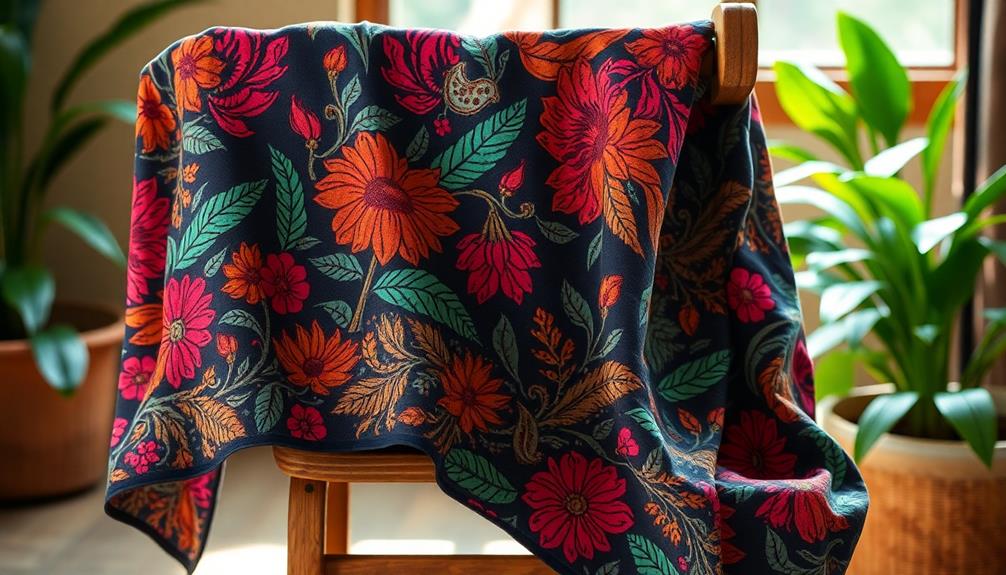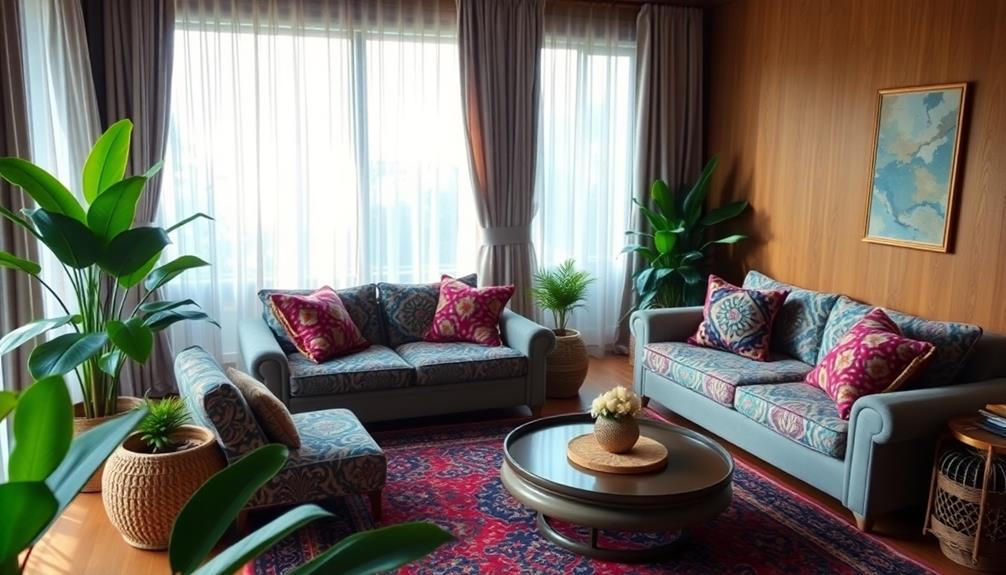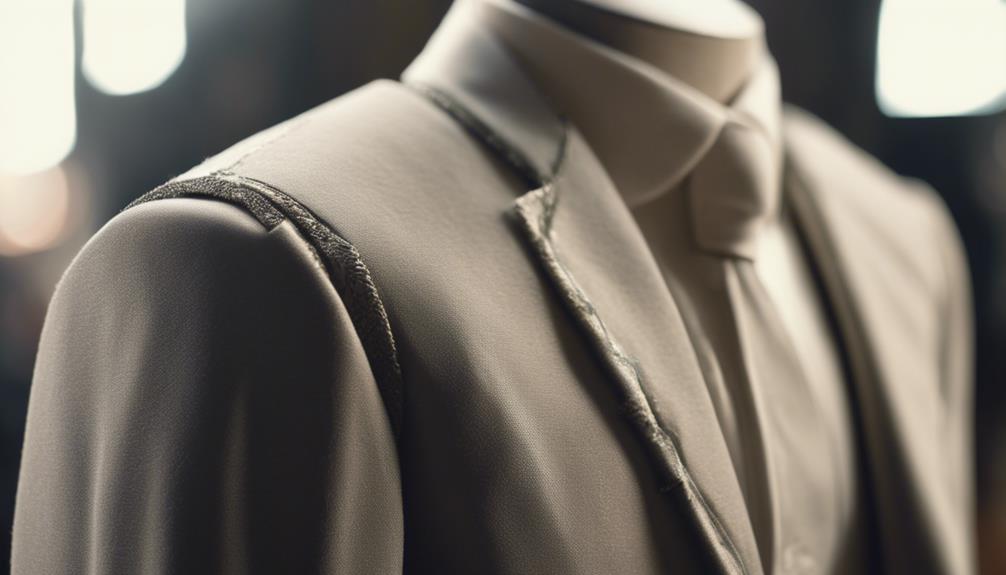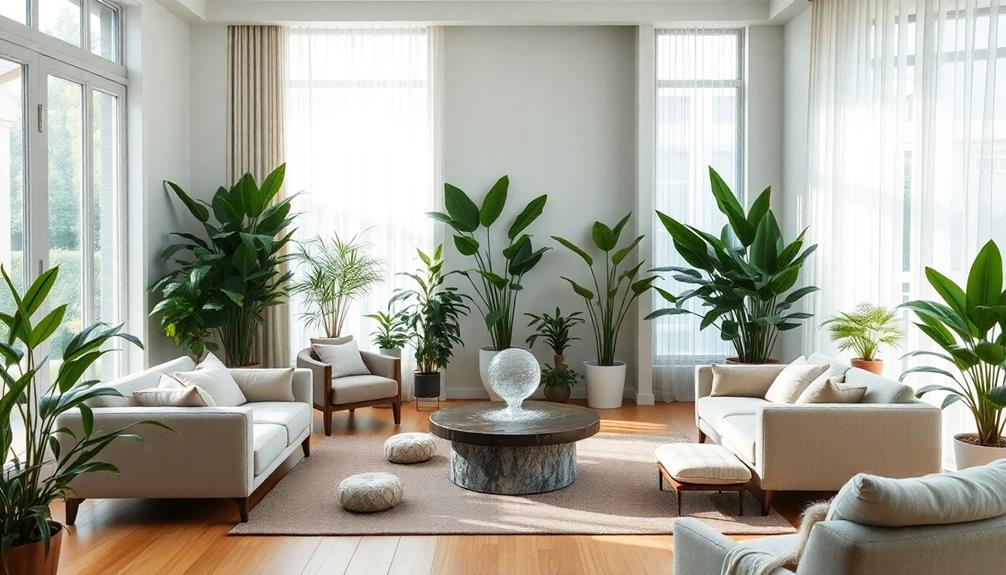Batik designs don't just enhance aesthetics; they bring rich cultural stories into your home. Each motif carries significant meaning, like Parang, which symbolizes protection and bravery, or Kawung, representing balance and harmony. The vibrant colors also play a role, conveying emotions like tranquility or energy. By incorporating batik pieces, whether in cushions or wall art, you're creating a space filled with depth and narrative. This unique blend of tradition and modern design can transform your environment. Plus, exploring specific motifs will enrich your appreciation for this art form even further.
Key Takeaways
- Batik designs, such as Parang and Kawung, carry deep cultural meanings, enriching spaces with stories and heritage.
- The wax-resist dyeing process creates unique patterns that reflect Indonesia's artistic craftsmanship over 2000 years.
- Incorporating batik in home decor, like cushions or wall art, adds vibrant cultural significance and enhances aesthetic appeal.
- Regional variations in batik styles convey different cultural values, allowing for personalized storytelling in interior design.
- Balancing bold batik patterns with neutral elements creates an elegant atmosphere while showcasing the significance of the designs.
Understanding Batik Fabric
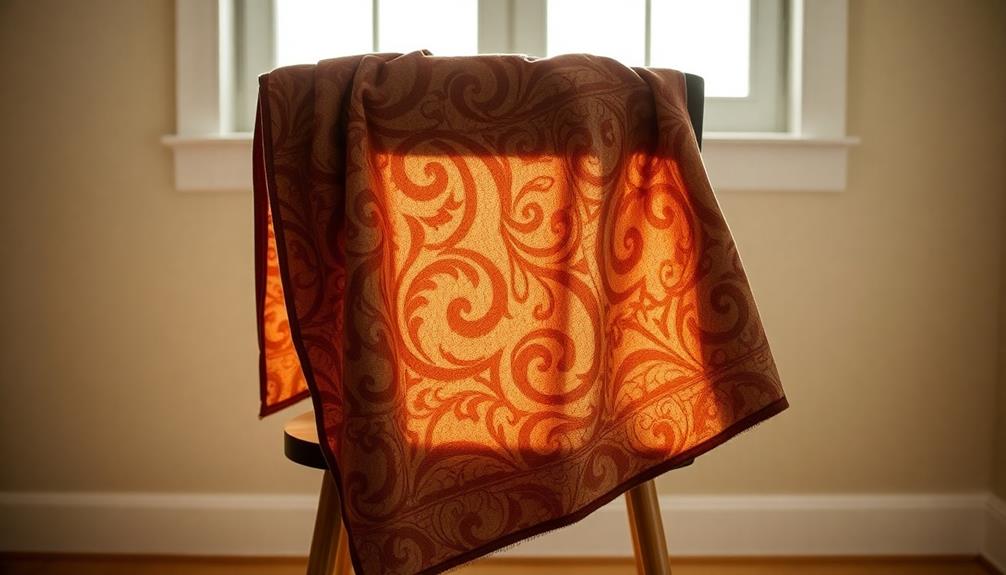
Batik fabric is a fascinating textile that showcases intricate designs through a unique wax-resist dyeing process. You apply hot wax to the fabric before immersing it in dye baths, allowing for distinctive patterns to emerge once the wax is removed. This method creates vibrant colors that are both eye-catching and rich in cultural significance.
The term "batik" originates from the Javanese word "bathikan," emphasizing its artistic nature. Additionally, batik art often parallels the rich traditions found in other forms of Indonesian decor, such as traditional artistry seen in masks, which also reflect deep cultural narratives.
Understanding batik involves appreciating its traditional roots and the various techniques used, such as Batik Tulis (hand-drawn), Batik Cap (stamped), and Batik Lukis (painted). Each type offers a different level of detail and complexity in the designs.
The motifs in batik often carry cultural significance; for instance, the Parang pattern symbolizes the struggle against evil forces, while the Kawung pattern represents balance in life.
As you explore batik fabric, you'll find that it's typically made from materials like cotton or silk, enhancing its appeal. With its intricate designs and vibrant colors, batik serves not just as a fabric but as a canvas of cultural history waiting for your understanding and appreciation.
Symbolism in Batik Patterns
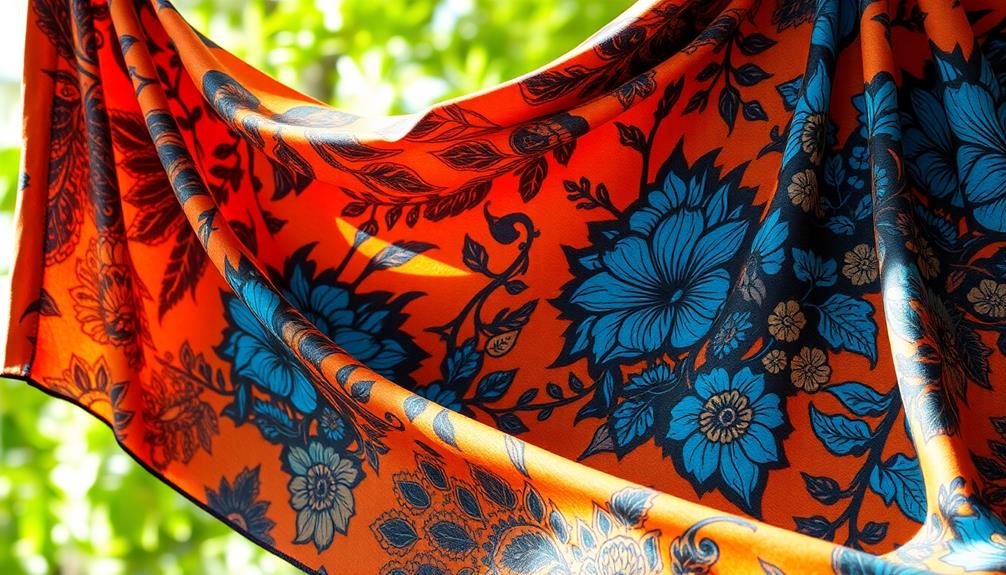
Often, batik patterns are rich with symbolism, reflecting deep cultural beliefs and narratives. Each design tells a story, connecting you to the cultural heritage of the fabric. For instance, the "Parang" pattern embodies protection and bravery, symbolizing the struggle against evil forces. In contrast, the "Kawung" features geometric patterns that signify balance and harmony, representing life's cyclical nature.
Here's a quick overview of some key batik patterns and their symbolism:
| Pattern | Symbolism | Colors |
|---|---|---|
| Parang | Protection and bravery | Red (passion) |
| Kawung | Balance and harmony | Blue (calmness) |
| Sido Mukti | Prosperity and good fortune | Gold (wealth) |
Colors play a significant role in these designs. Red symbolizes bravery, while blue conveys tranquility. By incorporating these traditional motifs into your space, you invite the essence of these narratives and their meanings, enriching your environment with the depth of batik patterns. Embrace the stories and symbolism behind these beautiful designs to enhance your living space.
Historical Significance of Batik

Although its intricate designs and rich symbolism are widely appreciated today, batik's historical significance runs much deeper. Originating in Indonesia, specifically on the island of Java, batik boasts a history that dates back over 2000 years, making it one of the oldest textile traditions. The term "batik" stems from the Javanese word "ambatik," meaning cloth with little dots, which reflects its elaborate craftsmanship. The vibrant colors and intricate patterns of batik not only enhance living spaces but also serve as a reflection of Indonesia's cultural heritage, as seen in various Indonesian decorative pillows.
Initially, batik served as a medium for spiritual expression, with each pattern and color carrying symbolic meanings tied to various cultural rituals. For example, the "Parang" pattern symbolizes the struggle against evil forces, showcasing the depth of the designs.
Traditional techniques, such as wax-resist dyeing, are essential in creating these intricate patterns, allowing artisans to convey stories and beliefs through fabric.
In 2009, UNESCO recognized batik as a Masterpiece of the Oral and Intangible Heritage of Humanity, underscoring its cultural importance and the traditional practices that have been passed down through generations.
Regional Variations and Their Meanings

Exploring the rich tapestry of batik reveals a fascinating array of regional variations, each with its own unique meanings and artistic expressions. When you investigate these batik designs, you'll find they reflect the local beliefs and cultural heritage of their origins.
| Region | Characteristics |
|---|---|
| Central Java | Classic, intricate designs symbolizing nobility and spirituality. |
| Yogyakarta batik | Elaborate motifs that narrate historical tales, often linked to the royal family. |
| Pekalongan batik | Vibrant colors and modern themes, featuring floral and nature-inspired designs. |
| Bali batik | Incorporates natural elements and spiritual symbols, reflecting the island's traditions. |
| Overall Impact | Each style serves as a visual language conveying cultural values and stories. |
Contemporary Applications in Decor
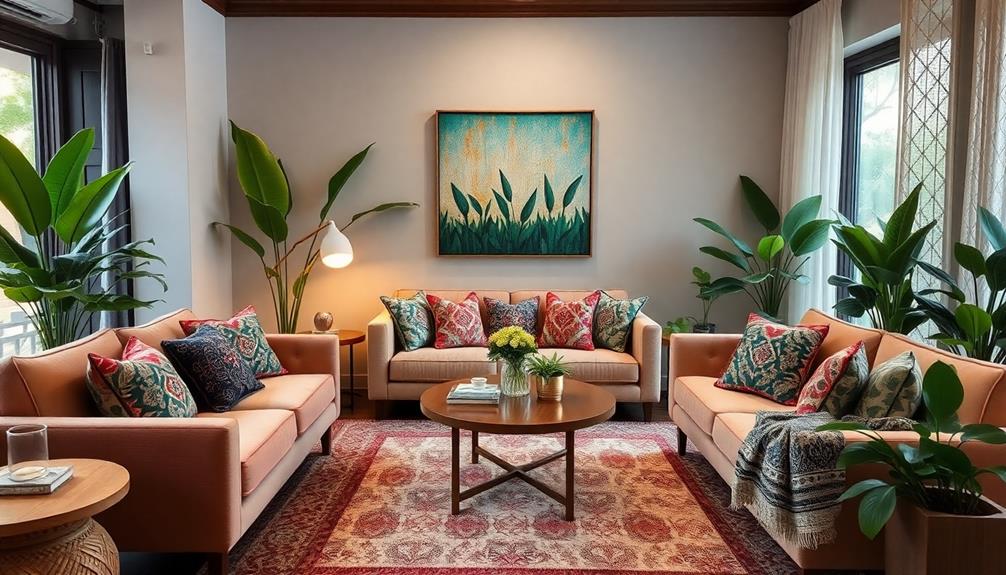
Batik designs regularly find their way into contemporary decor, infusing spaces with vibrant cultural significance. These designs, much like the traditional craftsmanship seen in Indonesian decor masks, resonate with the rich heritage of Indonesia.
You can easily incorporate batik textiles into your home decor through accent pieces like cushions, throws, and curtains. These items not only add a vibrant cultural touch but also bring warmth and character to any room. Consider using batik as stunning wall art; the intricate designs and patterns can serve as focal points, showcasing the craftsmanship and rich narratives behind the fabric.
Designers are creatively blending traditional techniques with modern design elements by incorporating batik-inspired motifs into various decor items, such as table runners and upholstery. This fusion promotes a unique artistic feel, allowing you to personalize spaces while connecting to cultural heritage and storytelling.
Whether you live in a small urban apartment or a spacious vacation home, batik's versatility makes it suitable for a wide range of interior styles and preferences. By embracing batik, you're not just decorating; you're celebrating a rich cultural legacy that adds depth and meaning to your environment.
Incorporating Batik in Home Design

Incorporating batik in your home design brings unique cultural storytelling to life through its vibrant patterns.
These designs often reflect rich heritage and traditions, much like the importance of Indonesian decor masks.
You can easily integrate batik with versatile applications, like pillows or wall art, that enhance your space's aesthetic.
Unique Cultural Storytelling
When you choose to integrate batik designs into your home decor, you're not just adding color and pattern; you're weaving rich narratives steeped in cultural significance into your living space. Each batik piece carries a story, reflecting the intricate craftsmanship and traditions of Indonesian culture. For instance, the Parang pattern symbolizes the struggle against evil forces, making it a powerful narrative element in your decor.
Here's a glimpse into some popular batik motifs and their meanings:
| Batik Pattern | Cultural Significance |
|---|---|
| Parang | Represents the struggle against evil |
| Kawung | Symbolizes balance and harmony |
| Mega Mendung | Reflects hope and prosperity |
| Cuwiri | Represents the journey of life |
| Sido Mukti | Represents the wish for prosperity |
Versatile Design Applications
Integrating batik into your home design opens up a world of versatile applications that enhance both style and cultural depth. You can use batik fabric in various ways, such as accent pieces like cushions, throws, and curtains. These additions infuse your space with vibrant colors and intricate patterns, elevating your interior design effortlessly.
To create an even more cohesive look, consider blending batik with natural materials such as wood and stone, which are essential in Balinese interior design concepts.
Consider using batik as wall-mounted art displays or tapestries. They serve as enchanting focal points, adding cultural richness to any room. By incorporating batik into your home decor, you also embrace personalization, as these unique designs often carry cultural meanings and stories that reflect your family heritage or personal connections.
To achieve a cohesive and elegant atmosphere, balance batik with crisp, plain elements to avoid an overly thematic or cluttered look. Its versatility extends beyond accent pieces; you can integrate batik into bedding, upholstery, and even table runners, making it suitable for both small urban apartments and larger vacation homes.
With thoughtful application, batik can transform your space, allowing you to express your style while honoring the cultural significance behind these exquisite designs.
Practical Tips for Using Batik

When you're choosing batik pieces for your home, focus on authentic options that fit your budget to honor the craft's cultural roots.
Incorporating batik into your decor can beautifully reflect local culture while adding a unique touch to your space, as seen in traditional Indonesian style home decor.
Balancing these vibrant patterns with neutral elements can help create a sophisticated atmosphere.
Consider how the colors and designs interact to enhance your overall decor without overwhelming the space.
Choosing Authentic Batik Pieces
Selecting authentic batik pieces can transform your space into a vibrant celebration of culture and artistry. When you choose batik, prioritize options that showcase traditional craftsmanship.
Look for intricate hand-drawn designs (Batik Tulis) or stamped patterns (Batik Cap), which reflect the skill and heritage of Indonesian artisans. Research regional styles, like Pekalongan's vivid colors or Yogyakarta's elaborate motifs, to find pieces that resonate with specific cultural narratives.
Additionally, consider the impact of traditional Indonesian housing on the presentation of batik, as these homes often serve as community gathering spaces where art and culture intertwine. This connection emphasizes the importance of the cultural significance of housing in Indonesia.
To guarantee quality, opt for natural materials such as cotton or silk. These fabrics not only enhance durability but also age beautifully, adding to the tactile appeal of your decor.
Consider these elements for a deeper connection to your batik choices:
- Cultural significance: Understand the meanings behind patterns, like Parang symbolizing power or Kawung representing balance.
- Storytelling: Each design tells a unique story, fostering a connection between you and the artwork.
- Quality craftsmanship: Choose pieces that reflect the artisans' dedication and skill, ensuring your batik is truly authentic.
Balancing Patterns and Colors
Balancing patterns and colors in your decor can elevate the beauty of batik while maintaining a harmonious space. To achieve elegance, pair vibrant batik patterns with crisp, solid colors. This prevents a cluttered appearance, allowing the intricate designs to shine.
Consider incorporating elements of Boho Above Bed Decor, such as macramé hangings, to enhance the overall texture of your space. Use batik fabrics as accent pieces—think throw pillows or cushions—to introduce color and texture without overwhelming the room.
If you prefer a more subtle look, consider experimenting with muted color palettes in batik. These create a refined ambiance and enhance sophistication while still showcasing rich cultural storytelling.
When you incorporate multiple batik pieces, guarantee a cohesive look by selecting designs that share a common color scheme or thematic elements. This reinforces harmony throughout your space.
Additionally, incorporate batik in smaller doses, like framed wall art or table runners. These focal points draw attention while maintaining a balanced overall aesthetic.
Celebrating Batik's Cultural Heritage

Batik weaves a vibrant tapestry of Indonesia's cultural heritage, showcasing intricate designs that resonate with deep meanings and historical significance.
Recognized by UNESCO as a Masterpiece of the Oral and Intangible Heritage of Humanity, traditional batik embodies more than just aesthetic appeal; it serves as a storytelling medium, reflecting the rich narratives of communities.
Incorporating traditional motifs and patterns in batik designs can enhance the cultural significance of any space, making it a perfect choice for Indonesian Wedding Decor.
- Each intricate pattern conveys specific messages, such as the "Parang," symbolizing the struggle against evil forces, and the "Kawung," representing balance and direction.
- The wax-resist dyeing process highlights the craftsmanship involved, with techniques honed over 2000 years.
- Regional variations from places like Central Java, Yogyakarta, and Pekalongan showcase unique styles that reflect local traditions and social status.
Frequently Asked Questions
What Is the Significance of Batik Design?
Batik design's significance lies in its rich symbolism and unique craftsmanship. Each pattern and color tells a story, reflecting cultural heritage and personal values, making your space not just visually appealing, but meaningful too.
What Is the Meaning of Batik Pattern Design?
So, you think batik patterns are just pretty fabrics? Think again! Each design tells a story, like "Parang" fighting evil or "Sido Mukti" wishing you prosperity. Immerse yourself in their meanings, and embrace your vibrant heritage!
What Does the Batik Symbol Mean?
Batik symbols represent rich cultural meanings. For instance, the "Parang" signifies the struggle against evil, while "Kawung" embodies balance. Each symbol tells a story, reflecting values, social status, or life events uniquely through art.
What Is the Meaning of Batik Making?
Batik making's meaning lies in its rich cultural heritage and storytelling. As you explore this art form, you'll discover how each intricate design weaves together tradition, identity, and a connection to community through vibrant colors.
Conclusion
Incorporating batik into your space isn't just about aesthetics; it's about weaving stories into your home. Each design carries a rich tapestry of meaning, inviting conversations and reflections. So, why settle for ordinary decor when you can celebrate cultural heritage? By embracing batik, you're not just decorating; you're creating a vibrant dialogue between past and present. Let your walls tell a story, and watch as your space transforms into a sanctuary of history and creativity.

